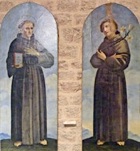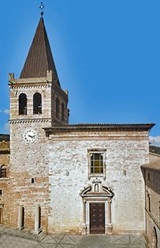
The church was built on what was probably the site of a Roman temple. It was documented in 1025 and again in 1178, when it belonged to the Abbazia di San Silvestro. The Emperor Henry VI separated it from San Silvestro and took it under his protection in 1187, from which point it was administered by a college of canons.
The Romanesque base of the campanile to the left of the façade dates to the 12th century. [A bell cast in 1209 that was originally in this tower is now in the Pinacoteca Comunale]. According to its inscription, Bencivenni da Pisa cast it when Giacomo da Bevagna was Prior.
The Maccarelli family financed the restoration of the church in 1285. At that time, a community of secular canons administered it, but in 1298 they became regular canons, holding their property in common. The foundation remained important throughout the 14th century, but subsequently declined.
Prior Marino d’ Agostino, who served in 1449-63 and then from 1475 until his death in 1499 was responsible for the revival of the fortunes of Santa Maria Maggiore in the second half of the 15th century. The process continued under Troilo Baglioni (1499-1501) and Leone Baglioni (1507-39, the illegitimate son of Troilo’s powerful brother, Gian Paolo Baglioni). Bishop Francesco Eroli of Spoleto consecrated the new high altar in 1513, during what was a major period of renovation.
The church of Santa Maria di Armenzano was subordinated to Santa Maria Maggiore in 1562, followed by the church of San Rufino di Spello in 1564.
The church was re-modelled in the period 1644-90, when the façade was moved forward to form an additional bay within the church at the expense of what had been a portico. The fluted marble columns at its base of the campanile (visible in the photograph above), which probably came from a Roman building, may have been re-used in this portico.
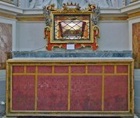
The community of canons was suppressed in 1860.
Exterior
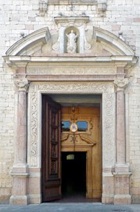
Following this modification, the facade of the church continued the line of the original campanile (13th century). A second bell tower, the so-called Campanile dell’ Annunziata, was built behind and to the left of the church in 1527 to a design by Rocco di Tommaso da Vicenza.
Interior
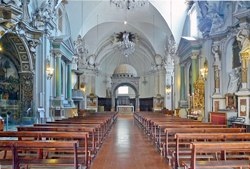
The church has a single nave, a transept and an apse.
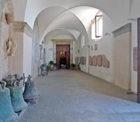
Roman Funerary Altar (1st half of the 1st century AD)
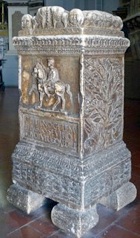
Presbytery
This area of the church retains a number of elements from the remodelling of the early 16th century.

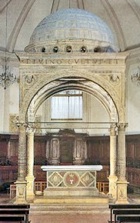
Agony in the Garden (ca. 1391)
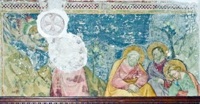
This damaged fresco, which is signed by Cola Petruccioli and, can be seen on the left of the apse, behind the choir stalls. It was probably originally part of a cycle of scenes from the life of Christ that was largely destroyed when the presbytery was re-modelled.
[A fragment from it showing the head of Christ is now in the Cappella dei Canonici (see below)].
Font (1510-11)
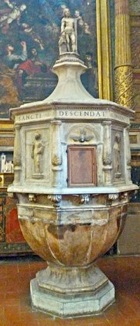

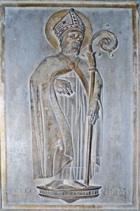
Detached frescoes (1521)
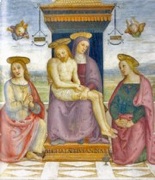
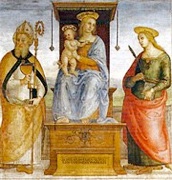
These panels were commissioned for two altars (1515) that Rocco di Tommaso da Vicenza built on the pilasters that flank the presbytery. He negotiated a contract for their altarpieces with Giannicola di Paolo in 1520, but this contract was never honoured, and the work was commissioned from the elderly Perugino in 1521.
The altars were destroyed in 1644, but the altar walls and their frescoes survive in their original locations. The frescoes depict:
-
✴the Madonna enthroned with the dead Christ, with SS John the Evangelist and Mary Magdalene, which is signed by Perugino (on the left); and
-
✴the Madonna and Child with SS Blaise and Catherine of Alexander.
Both works are dated by inscription and each names the donor (respectively Michelangelo Andine and Giovanni Bernadelli) in an inscription along the base of the throne.
Pulpit (1545)
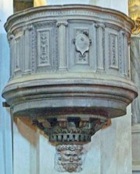
Madonna of the Girdle (ca. 1650)
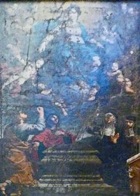
Stigmatisation of St Francis (ca. 1652)
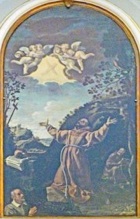
Stucco Altars (ca. 1670)
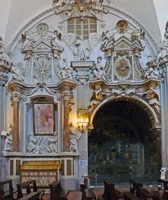
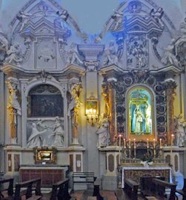
Altare di San Giuseppe and Altare di San Felice and
entrance wall of Cappella Bella Altare della Madonna del Rosario
An inscription on the choir on the counter-façade records that Cardinal Bishop Cesare Facchinetti of Spoleto commissioned the re-decoration of the church in 1670. The design for this project, which probably involved the stucco decoration of almost the whole of the interior, is attributed to Agostino Silva. Specific altars that are attributed to him include:
-
✴the Altare di San Giuseppe and the entrance wall of the Cappella Bella on the left;
-
✴the Altare di San Felice and the Altare della Madonna del Rosario on the right; and
-
✴two altars in the transepts:
-
•the Altare di San Gaetano di Thiene, on the left; and
-
•the Altare della Madonna di Loreto, on the right.
Panels (ca. 1700)
These panels, which are attributed to Carlo Lamparelli include:
-
✴fifteen tondi (ca. 1670) of scenes from the Passion of Christ on the Altare della Madonna del Rosario (in the 2nd bay on the right); and
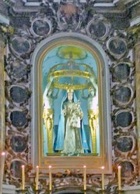
-
✴the Immaculate Virgin with SS Agnes, Antony of Padua, Felix, Clare and a female saint on the left of the left transept, which came from Santa Chiara.
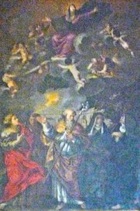
Madonna della Collegiata (1984)
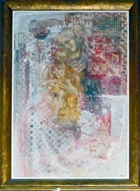
Cappella Bella
This chapel (the 2nd on the left) is known as the Cappella Bella, in honour of its magnificent frescoes (1501) by Pintoricchio. It was originally the Cappella del Sacramento, but this function was transferred to the ex-sacristy (the present Cappella del SS Sacramento - see below) in 1875, when the Cappella Bella was closed for restoration.
Cappella del SS Sacramento (1478)
This chapel is off the left transept, which originally served as the sacristy, was commissioned by Prior Marino d’ Agostino from the Lombard masters, Antonio and Giovanetto. It seems to have been designated as the Cappella del Sacramento in 1875, because the Cappella Bella, which had previously served this purpose, was closed for restoration at that time.
An inscription on the inlaid chest (1500) gives the date and the names of :
-
✴Bishop Francesco Eroli of Spoleto;
-
✴Troilo Baglioni, the Prior of Santa Maria Maggiore, who commissioned the work; and
-
✴Pollione di Gasparo da Foligno, who executed it.
Fresco of an angel (ca. 1500)
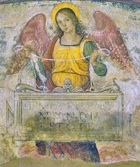
Tabernacle (1562)
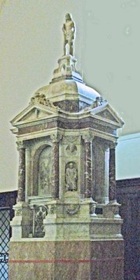
-
✴a bronze relief of the Resurrection in the lower part of the side facing the congregation;
-
✴figures of the Evangelists and reliefs of their symbols in the four narrower sides; and
-
✴a figure of the Risen Christ above.
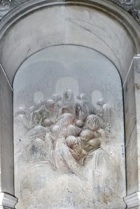
-
✴the Madonna del Latte;
-
✴the Last Supper;
-
✴the Crucifixion; and
-
✴the descent of the Holy Spirit (illustrated here).
Panels (17th century)
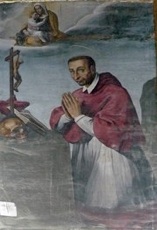
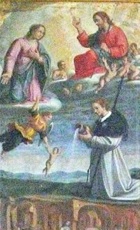
These two panels by Marcantonio Grecchi depict:
-
✴St Charles Borromeo; and
-
✴the Virgin of Mount Carmel (Virgin intercedes with Jesus for the souls in Purgatory), with [which saint ??] and a townscape of Spello below.
Cappella dei Canonici
This chapel is behind the Cappella del Sacramento, off the left transept.
[Choir stalls (1503-5) by Pollione di Gasparo da Foligno]
[Head of Christ (ca. 1391)
This fragment came from the fresco of Christ’s agony in the garden in the apse (see above), which is signed by Cola Petruccioli ].
Madonna and Child (1501)
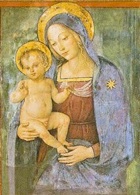
Madonna and Child (repainted in ca. 1500)
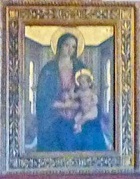
The central panel was presumably also originally the work of the Maestro dell’ Assunta di Amelia. However, it was extensively repainted in ca. 1500, although the throne seems to be largely original. Its present frame was probably executed at the time of the over-painting, which has been attributed to Andrea d’ Assisi, l’ Ingegno, who might also have been involved in Pintoricchio’s work in the Cappella Bella.
The polyptych was dismembered at an unknown time and its panels were then used on individual altars. The central panel and one of the predella panels were stolen in 1970, but they were fortunately recovered in 1992.
Coronation of the Virgin (date?)
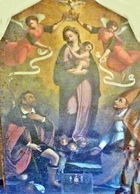
Cappella del Crocifisso
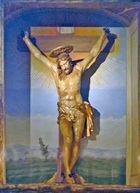
St Sebastian (1538)
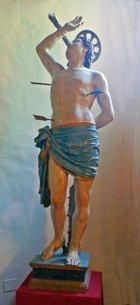
Madonna and Child with saints (16th century)
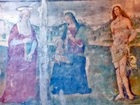
Madonna and Child with saints (early 16th century)
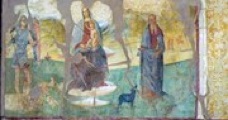
This detached fresco in the chapel adjoining the Cappella del Crocifisso, which is from San Michele Arcangelo, depicts of the Madonna and Child with SS Michael and Antony Abbot. The artist was a follower of Andrea d' Assisi, l’ Ingegno.
Art from the Church
The following works are now in the Pinacoteca Comunale:
Madonna and Child (ca. 1300)
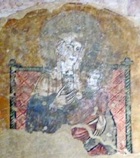
Crucified Christ (early 14th century)
This painted wooden figure of Christ was rediscovered in 1974 in a store room in Santa Maria Maggiore. It has moveable arms, which would have allowed it to be removed from a cross and taken in procession at Easter. [This was not displayed in 2009]
Diptych (1391)
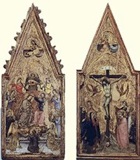
-
✴the Crucifixion with:
-
•the Virgin and SS John the Baptist and Mary Magdalene on the left;
-
•SS John the Evangelist, Nicholas of Bari and Catherine of Alexandria on the right; and
-
•the Archangel Gabriel above; and
-
✴the Coronation of the Virgin with musical angels, and the Virgin Annunciate above.
Processional Cross (1398)
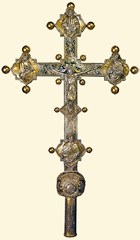
Panels from a triptych (early 15th century)
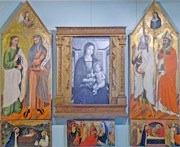
These panels came from a polyptych that was probably originally commissioned for the high altar. It was dismembered at an unknown time and its panels were then used on individual altars. This central panel and one of the predella panels were stolen in 1970, but they were fortunately recovered in 1992. Most of the panels are now in the Pinacoteca, although the central panel there is replaced by a photograph.
Following a recent restoration, the side panels and predella panels have been attributed to the Maestro dell’ Assunta di Amelia:
-
✴The side panels depict:
-
•St John the Evangelist and Isaiah, with the Archangel Gabriel above (on the left);
-
•SS John the Baptist and Nicholas of Bari, with the Virgin Annunciate above (on the right).
-
Their restoration revealed tiny kneeling donors that had been over-painted.
-
✴The predella panels depict scenes from the early life of Christ:
-
•the nativity;
-
•the adoration of the Magi; and
-
•the presentation of Christ at the Temple.
The central panel, which was extensively repainted in ca. 1500, is now in the Cappella dei Canonici (see above).
Madonna of the Rosary (late 16th century)
This panel, which is attributed to Ascensidonio Spacca, il Fantino, was documented following the Apostolic Visit of 1610, when it was on the Altare del Rosario, to the right of the entrance. It was removed when the church was re-modelled in 1644-90. It depicts SS Dominic, Peter Martyr and Catherine of Siena and another female Dominican saint receiving rosaries from the Madonna and Child while, below, a pope and a group of nobles kneel in front of the choir of a church that is clearly identifiable as Santa Maria Maggiore. A small coat of arms on the cope of the papal figure identify him as the Dominican Pope Pius V, who instituted the feast of the rosary after the Battle of Lepanto (1571).
This panel was probably executed after the formation of the Society of the Rosary at Santa Maria Maggiore in 1590. The description of the panel in 1610 identifies the lay people depicted in it as members of this society. This group includes two small children and a baby in the arms of its nurse. [This panel was not displayed in 2009]
Works by or attributed to Marcantonio Grecchi
These works by or attributed to Marcantonio Grecchi were (unless otherwise stated) probably removed from the church during the re-modelling of 1644:
-
✴Madonna and Child in glory with saints (1603)
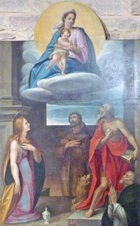
-
This altarpiece, which is signed and dated by inscription, depicts the Madonna and Child with SS Mary Magdalene, Francis, Jerome and Raymond of Peñafort (a Dominican who died in 1275 and was canonised by Pope Clement VIII in 1601).
-
-
-
-
-
-
-
St Antony Abbot enthroned (1604)
-
This altarpiece, which is dated by inscription and attributed to Marcantonio Grecchi, contains a portrait of the unknown donor.
-
✴St Felix Altarpiece (ca. 1610)
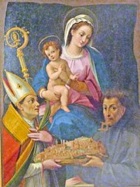
-
This altarpiece, which depicts the Madonna and Child with St Felix and the Blessed Andrew Caccioli, is attributed to Marcantonio Grecchi. It is probably the altarpiece that was removed from the Altare di San Felice in 1930. It provides evidence that both of these saints were considered to be patrons of Spello in the early 17th century.
-
-
✴St Felix with angels (1617)
-
This altarpiece, which is signed and dated by inscription, depicts the standing St Felix with two angels, one of whom holds a cityscape of Spello.
-
✴Madonna of Constantinople with saints (early 17th century)
-
This altarpiece, which is attributed to Marcantonio Grecchi, depicts the Madonna of Constantinople with St Michael (who holds the scales of justice in his left hand points the sword in his right hand at a dragon) and St Francis.
SS Bernardino of Siena and Antony of Padua (17th century)
Reliquary of St Felix (1788)
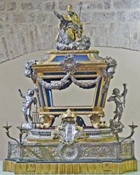
The relic in question, which came from San Felice di Giano, was probably housed in this reliquary above the Altare di San Felice. Its base contains holes for poles so that the relic could be taken in procession.
The relic was moved to another reliquary that is still housed there: this might have occurred in 1883, when the reliquary here was restored.






